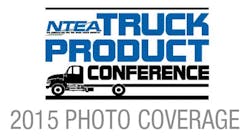TIM Ellsworth of Isuzu’s product planning department provided upfitter considerations:
• Component clearance. Design and installation of bodies and/or special equipment should allow for appropriate chassis component clearances. Examples are engine, transmission, prop shaft, axles, wheels/tires, exhaust system, brake lines, and fuel lines. See the Body Builders Guide for recommended clearances per model.
• Serviceability. Access to items that require routine service should not be obstructed. Examples are engine oil, coolant, transmission fluid, fan belts, batteries, brake system and fluid, fuel filler, and DEF fill.
“Something I hear quite often is clearance for filling a DEF tank,” he said. “Keep in mind there are multiple methods for filling DEF tanks. You have the standardized pump method and also the funnel and jug method.”
• Diesel coolant lines. All Isuzu diesel trucks MY2011-plus emissions use engine coolant heat to meet DEF thaw guidelines. Auxiliary heaters may not draw heat from engine coolant. Energy used for auxiliary heating may increase DEF thaw times beyond acceptable guidelines. Auxiliary heaters must contain a self-contained heat source.
• Diesel emission devices. No-modification zones: DEF tank, DEF lines, coolant lines, exhaust aftertreatment. Modification may cause calibration issues and void emissions compliance.
• Special bolt placement. Body-mounting bracket on right-hand chassis rail. Reinforcement block with U-bolt on left-hand chassis rail. Traditional U-bolt with wood reinforcement other locations.
• J-hook body mounts. Isuzu frames are not designed for J-hook mounting. This style of mounting may cause frame deformation, and will void the frame warranty.
• Frame modifications. Modification is allowed. Follow the Body Builder Guide for the proper procedure. Incorrect modification procedures may lead to frame failure.
• Wiring. Harness splicing is not recommended. Disconnect negative battery cable before chassis welding or any electrical modification. Use proper torque for battery cable terminal when reconnecting the battery. Provide harness protection near sharp edges. Star washers may create insufficient ground connections.
• Batteries. Common causes of low voltage: low ambient temperatures, vehicle storage, relocated batteries, battery cable length/size, corrosion, engine start and stop, auxiliary electrical equipment, and lighting systems left on. Isuzu electrical systems have become more sensitive to electrical integrity and require healthy circuits.
• Tail lamp connectors. Tail lamp harness connectors can be ordered through Isuzu dealers. Connectors match OE end of the frame. Chassis harness side P/N: 897364-5300. Tail lamp side P/N: 897364-5310.
• Backup alarm connector is located near the last crossmember at the left-hand frame rail. Reference the Body Builders Guide for part numbers.
• Dome lamp switch. An OE switch is available for rear body dome lamp application. Three installed options: port installed option IX2; dealer installed; and body company installed.
• WB modification harnesses. Harness splicing should be avoided if possible. Extension harnesses are available.
Earlier this year, Isuzu introduced its newest model—the 2016 NPR Diesel. The truck features a 13,000-lb GVWR and a 33.5-inch frame to offer more capability than previously available in an entry-level Isuzu diesel truck, according to the company.
With a 13,000-lb GVWR, the new NPR Diesel approaches the capacity of a Class 4 truck, but at a Class 3 price. Isuzu’s goal is to lower the cost of truck ownership without sacrificing performance, practicality, long-term reliability, or fuel efficiency.
Features of the 2016 NPR Diesel include:
• Standard 30-gallon rear-mounted in-rail fuel tank.
• Frame width of 33.5 inches that will accept bodies up to 102 inches wide and 91 inches high.
• Four wheelbases—109, 132.5, 150, and 176 inches—that will accept body lengths up to 20 feet.
The new NPR Diesel is powered by the 3.0-liter 4JJ1-TC turbocharged and intercooled diesel engine. The powerplant produces 150 horsepower and 282 lb-ft of torque at 1600 to 2800 rpm.
The engine has a B-10 diesel engine life rating of 310,000 miles. And in keeping with Isuzu’s commitment to environmental responsibility, the engine is capable of running on B20 biodiesel fuel.
The powerplant is mated to an Aisin A460 six-speed automatic transmission with double overdrive, lock-up torque converter that operates in second through sixth gears, and available PTO.
Production of the 2016 NPR Diesel will begin in Japan in November, and the truck will be available at Isuzu’s network of nearly 300 dealers in North America shortly thereafter.
The diesel-powered 2016 NPR-HD, NPR-XD, NQR, and NRR meet stringent new EPA greenhouse gas emissions standards a full year before they go into effect.
These models, as well as the 2015 NPR ECO-MAX, offer upgraded interiors, new exterior styling, and new optional driver’s suspension seat and keyless entry.
The 2015 NPR ECO-MAX and 2016 NPR-HD, NPR-XD, NQR and NRR benefit from all of the following enhancements as they enter their new model years:
• Onboard diagnostics (OBD) improved with a new particulate matter sensor.
• A new high-output 140-amp alternator generating 30 more amps than the equipment it replaces.
• An optional driver suspension seat that increases comfort as it reduces driver fatigue
The weight of the newest member of the Isuzu N-Series family, the 16,000-lb GVWR NPR-XD, has been reduced, allowing an increased payload capacity across all wheelbases and in both standard cab and crew cab configurations.









